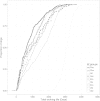Using the incidence and impact of behavioural conditions in guide dogs to investigate patterns in undesirable behaviour in dogs
- PMID: 27075868
- PMCID: PMC4831008
- DOI: 10.1038/srep23860
Using the incidence and impact of behavioural conditions in guide dogs to investigate patterns in undesirable behaviour in dogs
Abstract
The domestic dog is one of our most popular companions and longest relationships, occupying different roles, from pet to working guide dog for the blind. As dogs age different behavioural issues occur and in some cases dogs may be relinquished or removed from their working service. Here we analyse a dataset on working guide dogs that were removed from their service between 1994 and 2013. We use the withdrawal reasons as a proxy for the manifestation of undesirable behaviour. More than 7,500 dogs were in the dataset used, 83% of which were retired (due to old age) and 17% were withdrawn for behavioural issues. We found that the main reasons for behaviour withdrawal were environmental anxiety, training, and fear/aggression. Breed and sex had an effect on the odds of dogs being withdrawn under the different reasons. The age at withdrawal for the different withdrawal reasons suggested that dogs were more likely to develop fear/aggression related issues early on, whilst issues related to training could develop at almost any age. We found no evidence for heterosis effecting behaviour. We believe that this work is relevant to the pet dog population and had implications for understanding ageing and genetic influences on behaviour.
Figures




Similar articles
-
From "Husky" to "Bulldog"- behavioural correlates between castration and breed groups in the domestic dog (Canis lupus familiaris).BMC Vet Res. 2024 Jun 3;20(1):238. doi: 10.1186/s12917-024-04097-6. BMC Vet Res. 2024. PMID: 38831350 Free PMC article.
-
Using the incidence and impact of health conditions in guide dogs to investigate healthy ageing in working dogs.Vet J. 2016 Jan;207:124-130. doi: 10.1016/j.tvjl.2015.10.046. Epub 2015 Nov 11. Vet J. 2016. PMID: 26616425
-
Prevalence, comorbidity, and breed differences in canine anxiety in 13,700 Finnish pet dogs.Sci Rep. 2020 Mar 5;10(1):2962. doi: 10.1038/s41598-020-59837-z. Sci Rep. 2020. PMID: 32139728 Free PMC article.
-
Understanding and treating equine behavioural problems.Vet J. 2023 Jun-Jul;296-297:105985. doi: 10.1016/j.tvjl.2023.105985. Epub 2023 Apr 29. Vet J. 2023. PMID: 37127134 Review.
-
Lead pulling as a welfare concern in pet dogs: What can veterinary professionals learn from current research?Vet Rec. 2022 Nov;191(10):e1627. doi: 10.1002/vetr.1627. Epub 2022 May 12. Vet Rec. 2022. PMID: 35546517 Review.
Cited by
-
A New Metric for Quantifying the Relative Impact of Risk Factors on Loss of Working Life Illustrated in a Population of Working Dogs.PLoS One. 2016 Nov 9;11(11):e0165414. doi: 10.1371/journal.pone.0165414. eCollection 2016. PLoS One. 2016. PMID: 27829045 Free PMC article.
-
Concurrent and Predictive Criterion Validity of a Puppy Behaviour Questionnaire for Predicting Training Outcome in Juvenile Guide Dogs.Animals (Basel). 2020 Dec 11;10(12):2382. doi: 10.3390/ani10122382. Animals (Basel). 2020. PMID: 33322634 Free PMC article.
-
Enhancing the Selection and Performance of Working Dogs.Front Vet Sci. 2021 May 12;8:644431. doi: 10.3389/fvets.2021.644431. eCollection 2021. Front Vet Sci. 2021. PMID: 34055947 Free PMC article. Review.
-
Development of a modified C-BARQ for evaluating behavior in working dogs.Front Vet Sci. 2024 Jun 28;11:1371630. doi: 10.3389/fvets.2024.1371630. eCollection 2024. Front Vet Sci. 2024. PMID: 39005721 Free PMC article.
-
Enhancing Success of Veterinary Visits for Clients With Disabilities and an Assistance Dog or Companion Animal: A Review.Front Vet Sci. 2019 Feb 25;6:44. doi: 10.3389/fvets.2019.00044. eCollection 2019. Front Vet Sci. 2019. PMID: 30859106 Free PMC article. Review.
References
-
- King T., Marston L. C. & Bennett P. C. Breeding dogs for beauty and behaviour: Why scientists need to do more to develop valid and reliable behaviour assessments for dogs kept as companions. Appl. Anim. Behav. Sci. 137, 1–12 (2012).
-
- Asher L. et al.. A standardized behavior test for potential guide dog puppies: Methods and association with subsequent success in guide dog training. J. Vet. Behav. 8, 431–438 (2013).
-
- Slabbert J. & Odendaal J. Early prediction of adult police dog efficiency—a longitudinal study. Appl. Anim. Behav. Sci. 64, 269–288 (1999).
-
- Sinn D. L., Gosling S. D. & Hilliard S. Personality and performance in military working dogs: Reliability and predictive validity of behavioral tests. Appl. Anim. Behav. Sci. 127, 51–65 (2010).
MeSH terms
LinkOut - more resources
Full Text Sources
Other Literature Sources
Medical
Molecular Biology Databases
Research Materials

